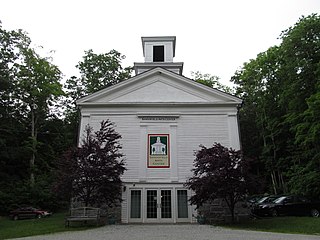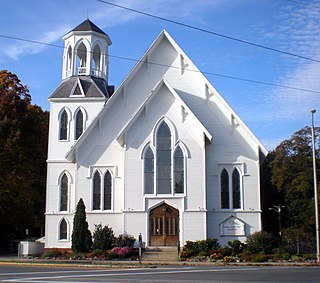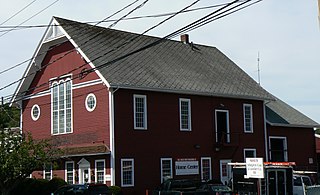
The First Baptist Church is a historic American Baptist Churches USA congregation, established in 1665. It is one of the oldest Baptist churches in the United States. It first met secretly in members homes, and the doors of the first church were nailed shut by a decree from the Puritans in March 1680. The church was forced to move to Noddle's Island. The church was forced to be disguised as a tavern and members traveled by water to worship. Rev. Dr. Stillman led the church in the North End for over 40 years, from 1764 to 1807. The church moved to Beacon Hill in 1854, where it was the tallest steeple in the city. After a slow demise under Rev. Dr. Rollin Heber Neale, the church briefly joined with the Shawmut Ave. Church, and the Warren Avenue Tabernacle, and merged and bought the current church in 1881, for $100,000.00. Since 1882 it has been located at the corner of Commonwealth Avenue and Clarendon Street in the Back Bay. The interior is currently a pending Boston Landmark through the Boston Landmarks Commission.

The Lowell is an historic triple decker apartment house on 33 Lexington Avenue in Cambridge, Massachusetts. Built in 1900 to a design by local architect John Hasty, it is a rare multiunit building in the Brattle Street area outside Harvard Square. The Colonial Revival building has a swan's neck pediment above the center entry, which is echoed above the central second story windows. Doric pilasters separate the bays of the front facade, and the building distinctively has side porches, giving it added horizontal massing. It was built before the decision was made to locate the electrified trolleys on Mount Auburn Street instead of Brattle, a decision that reduced interest in building more multiunit housing in that area.

The Osterville Baptist Church is an historic Baptist church building at 824 Main Street in the Osterville village of Barnstable, Massachusetts. The white clapboarded wood-frame structure was built in 1837 for a congregation formed two years earlier. It is one of the older buildings in Osterville, and is a fine example of the Greek Revival with Gothic Revival elements. The church was listed on the National Register of Historic Places in 1987.

The Universalist Society Meetinghouse is an historic Greek Revival meetinghouse at 3 River Road in Orleans, Massachusetts. Built in 1834, it was the only Universalist church built in Orleans, and is architecturally a well-preserved local example of Greek Revival architecture. The Meeting House is now the home of the Orleans Historical Society and is known as the Meeting House Museum. It was listed on the National Register of Historic Places in 1999.

The Montville Baptist Church, now known as the Sandisfield Arts Center, is an historic former Baptist church and Orthodox Jewish synagogue at 5 Hammertown Road in Sandisfield, Massachusetts. The Greek Revival building was constructed in 1839 as a Baptist church. After 83 years as a Baptist church meeting house, the building was converted into use as an Orthodox synagogue for 75 years. In 1995 the Sandisfield Arts Center formed as a non-profit to preserve the building. The building was added to the National Register of Historic Places in 2006.

First Baptist Church is an historic Baptist church building at 30 Park Street in Methuen, Massachusetts. Built in 1869 for a congregation established in 1815, it is one of the town's finest examples of Carpenter Gothic architecture. It was listed on the National Register of Historic Places in 1984.

North Rochester Congregational Church is a historic Congregational church at 247 North Avenue in Rochester, Massachusetts. Built in 1841 for a congregation established in 1790, it is a high quality example of Greek Revival architecture. The church was listed on the National Register of Historic Places in 2008.

The Norfolk Grange Hall, previously known as First Baptist Church, is a historic Grange hall and former Baptist church at 28 Rockwood Road in Norfolk, Massachusetts. Built in 1863, it is one of the town's few surviving 19th-century civic buildings. Since 1921 it has been owned by the Norfolk Grange # 135 and used as its meeting hall. It was listed on the National Register of Historic Places in 1989.

The Arlington Coal & LumberCompany building is a historic commercial and civic building located in Arlington, Massachusetts. Built in 1875, it is a locally significant example of Late Gothic Revival architecture, with a long history as a community center. The building was listed on the National Register of Historic Places in 1985. The family-owned lumber yard has been has been in business at this location since 1923.

The Capt. Benjamin Locke House is a historic house in Arlington, Massachusetts. Built c. 1720, this 2+1⁄2-story wood-frame house is one of the oldest buildings in Arlington, with a distinctive place in its history. It was the home of Benjamin Locke, a captain of the Menotomy Minutemen, and a skirmish of the 1775 Battles of Lexington and Concord took place near the house. Locke sold the house in 1780 to a Baptist congregation, and it was used by them for services until 1790, when Locke bought it back. The building was the subject of legal action dealing with the separation of church and state, and was later the home of Locke's son, Lieutenant Benjamin Locke.

The First Congregational Church is an historic church in Stoneham, Massachusetts, United States. Built in 1840, it is a fine local example of Greek Revival architecture, and is a landmark in the town center. It was listed on the National Register of Historic Places on April 13, 1984. The church is affiliated with the United Church of Christ; the current pastor is the Rev. Ken McGarry.

South Reading Academy is a historic former school building at 7 Foster Street in Wakefield, Massachusetts, US. Built in 1828–29 for the First Baptist Church, the building has served as a religious school, public high school, clubhouse, and commercial space. The building was listed on the National Register of Historic Places in 1989.

The Brattle Street Church (1698–1876) was a Congregational and Unitarian church on Brattle Street in Boston, Massachusetts.

The Early Settlers Meeting House is a historic church building at the junction of Granite and Foggs Ridge roads at Leighton Corners in the town of Ossipee, New Hampshire, United States. Built in the 1810s for a Free Will Baptist congregation and remodeled in 1856, it is a well-preserved example of a vernacular mid-19th century church. Now owned by the Ossipee Historical Society, the building was listed on the National Register of Historic Places in 1995.

The First Free Will Baptist Church is a historic church on Granite Road in Ossipee, New Hampshire. The wood-frame white clapboarded building was built in 1856–57, and is a fine little-altered local example of a vernacular Greek Revival country church. The building was listed on the National Register of Historic Places in 1984.

The Old Union Meetinghouse, now the Union Baptist Church, is a historic church at 107 Mason Road in the Farmington Falls area of Farmington, Maine. Built in 1826–27, it is a high-quality and well-preserved example of a traditional late-colonial meetinghouse with Federal-style details. The building was listed on the National Register of Historic Places in 1973.

The First Congregational Church and Meetinghouse, also known as the Church of Christ and the Townshend Church, is a historic church at 34 Common Road in Townshend, Vermont. Built in 1790 and restyled in 1840, it is one of the oldest church buildings in continuous use in the state. The building was listed on the National Register of Historic Places in 2002; the congregation was established in 1777, and is affiliated with the United Church of Christ.

The Weare Town House is a historic New England meeting house on New Hampshire Route 114 in Weare, New Hampshire. Built in 1837, it is a good example of a period town hall/church combination with Federal and Gothic Revival features. Although its religious use has ended, it continues to be used for town offices as well as civic and social functions. The building was listed on the National Register of Historic Places in 1985.

The First Baptist Church of Northborough is a historic former church building at 52 Main Street. It is presently home to the Northborough Historical Society offices and museum. Built in 1860, it is a good local example of religious Italianate architecture, despite having lost its tower in the New England Hurricane of 1938. The building was listed on the National Register of Historic Places in 2016.

Brookline Baptist Church is a historic former church building at 632 Grassy brook Road in Brookline, Vermont. It was built in 1836 for a congregation established in 1785, and served the congregation regularly until 1945. It is now used as a community function space. It is a locally distinctive example of vernacular Gothic Revival architecture, and it was listed on the National Register of Historic Places in 2021.























